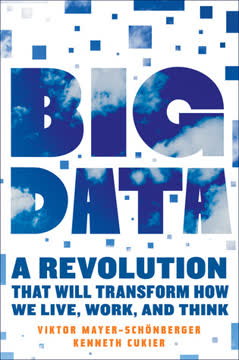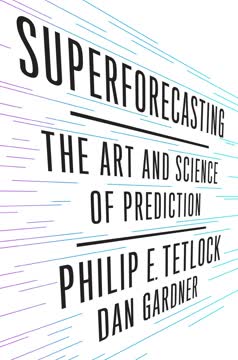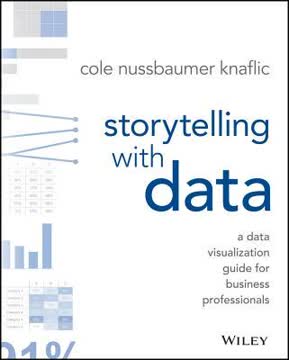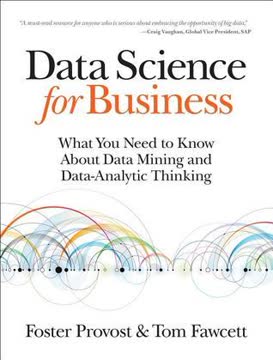Key Takeaways
1. Data science is about extracting actionable insights from data to solve business problems
Data-driven decision-making (DDD) refers to the practice of basing decisions on the analysis of data, rather than purely on intuition.
Business value of data science. Data-driven decision making has been shown to significantly improve business performance, with one study finding that companies who adopt DDD see 4-6% increases in productivity. Key business applications include:
- Customer analytics: Predicting churn, targeting marketing, personalizing recommendations
- Operational optimization: Supply chain management, predictive maintenance, fraud detection
- Financial modeling: Credit scoring, algorithmic trading, risk assessment
Core principles. Effective data science requires:
- Clearly defining the business problem and objectives
- Collecting and preparing relevant data
- Applying appropriate analytical techniques
- Translating results into actionable insights
- Measuring impact and iterating
2. Overfitting is a critical challenge in data mining that must be carefully managed
If you look too hard at a set of data, you will find something — but it might not generalize beyond the data you're looking at.
Understanding overfitting. Overfitting occurs when a model learns the noise in the training data too well, capturing random fluctuations rather than true underlying patterns. This results in poor generalization to new data.
Techniques to prevent overfitting:
- Cross-validation: Using separate training and test sets
- Regularization: Adding a penalty for model complexity
- Early stopping: Halting training before overfitting occurs
- Ensemble methods: Combining multiple models
- Feature selection: Using only the most relevant variables
Visualizing overfitting. Fitting curves show model performance on training and test data as model complexity increases. The optimal model balances underfitting and overfitting.
3. Evaluating models requires considering costs, benefits, and the specific business context
A critical skill in data science is the ability to decompose a data-analytics problem into pieces such that each piece matches a known task for which tools are available.
Evaluation metrics. Common metrics include:
- Classification: Accuracy, precision, recall, F1-score, AUC-ROC
- Regression: Mean squared error, R-squared, mean absolute error
- Ranking: nDCG, MAP, MRR
Business-aligned evaluation. Consider:
- Costs of false positives vs. false negatives
- Operational constraints (e.g., compute resources, latency requirements)
- Regulatory and ethical implications
- Interpretability needs for stakeholders
Expected value framework. Combine probabilities with costs/benefits to estimate overall business impact:
Expected Value = Σ (Probability of Outcome * Value of Outcome)
4. Text and unstructured data require special preprocessing techniques
Text is often referred to as "unstructured" data. This refers to the fact that text does not have the sort of structure that we normally expect for data: tables of records with fields having fixed meanings.
Text preprocessing steps:
- Tokenization: Splitting text into individual words/tokens
- Lowercasing: Normalizing case
- Removing punctuation and special characters
- Removing stop words (common words like "the", "and")
- Stemming/lemmatization: Reducing words to base forms
Text representation:
- Bag-of-words: Treating text as unordered set of words
- TF-IDF: Weighting words by frequency and uniqueness
- Word embeddings: Dense vector representations (e.g., Word2Vec)
- N-grams: Capturing multi-word phrases
Advanced techniques:
- Named entity recognition: Identifying people, organizations, locations
- Topic modeling: Discovering latent themes in document collections
- Sentiment analysis: Determining positive/negative sentiment
5. Similarity and distance measures are fundamental to many data mining tasks
Once an object can be represented as data, we can begin to talk more precisely about the similarity between objects, or alternatively the distance between objects.
Common distance measures:
- Euclidean distance: Straight-line distance in n-dimensional space
- Manhattan distance: Sum of absolute differences
- Cosine similarity: Angle between vectors (common for text)
- Jaccard similarity: Overlap between sets
- Edit distance: Number of operations to transform one string to another
Applications of similarity:
- Clustering: Grouping similar objects
- Nearest neighbor methods: Classification/regression based on similar examples
- Recommender systems: Finding similar users or items
- Anomaly detection: Identifying outliers far from other points
Choosing a distance measure. Consider:
- Data type (numeric, categorical, text, etc.)
- Scale and distribution of features
- Computational efficiency
- Domain-specific notions of similarity
6. Visualizing model performance is crucial for evaluation and communication
Stakeholders outside of the data science team may have little patience for details, and will often want a higher-level, more intuitive view of model performance.
Key visualization techniques:
- ROC curves: True positive rate vs. false positive rate
- Precision-recall curves: Precision vs. recall at different thresholds
- Lift charts: Model performance vs. random baseline
- Confusion matrices: Breakdown of correct/incorrect predictions
- Learning curves: Performance vs. training set size
- Feature importance plots: Relative impact of different variables
Benefits of visualization:
- Intuitive communication with non-technical stakeholders
- Comparing multiple models on the same plot
- Identifying optimal operating points/thresholds
- Diagnosing model weaknesses and biases
Best practices:
- Choose appropriate visualizations for the task and audience
- Use consistent color schemes and labeling
- Provide clear explanations and interpretations
- Include baseline/random performance for context
7. Probabilistic reasoning and Bayesian methods are powerful tools in data science
Bayes' Rule decomposes the posterior probability into the three quantities that we see on the righthand side.
Bayesian reasoning. Combines prior beliefs with new evidence to update probabilities:
P(H|E) = P(E|H) * P(H) / P(E)
- P(H|E): Posterior probability of hypothesis given evidence
- P(E|H): Likelihood of evidence given hypothesis
- P(H): Prior probability of hypothesis
- P(E): Probability of evidence
Applications:
- Naive Bayes classification
- Bayesian networks for causal reasoning
- A/B testing and experimentation
- Anomaly detection
- Natural language processing
Advantages of Bayesian methods:
- Incorporating prior knowledge
- Handling uncertainty explicitly
- Updating beliefs incrementally with new data
- Providing probabilistic predictions
8. Data preparation and feature engineering are essential for effective modeling
Often the quality of the data mining solution rests on how well the analysts structure the problems and craft the variables.
Data preparation steps:
- Data cleaning: Handling missing values, outliers, errors
- Data integration: Combining data from multiple sources
- Data transformation: Scaling, normalization, encoding categorical variables
- Data reduction: Feature selection, dimensionality reduction
Feature engineering techniques:
- Creating interaction terms
- Binning continuous variables
- Extracting temporal features (e.g., day of week, seasonality)
- Domain-specific transformations (e.g., log returns in finance)
Importance of domain knowledge. Effective feature engineering often requires:
- Understanding the business problem
- Familiarity with data generation processes
- Insights from subject matter experts
- Iterative experimentation and validation
9. Fundamental data mining tasks include classification, regression, clustering, and anomaly detection
Despite the large number of specific data mining algorithms developed over the years, there are only a handful of fundamentally different types of tasks these algorithms address.
Core data mining tasks:
- Classification: Predicting categorical labels (e.g., spam detection)
- Regression: Predicting continuous values (e.g., house price estimation)
- Clustering: Grouping similar instances (e.g., customer segmentation)
- Anomaly detection: Identifying unusual patterns (e.g., fraud detection)
- Association rule mining: Discovering relationships between variables
Common algorithms for each task:
- Classification: Decision trees, logistic regression, support vector machines
- Regression: Linear regression, random forests, gradient boosting
- Clustering: K-means, hierarchical clustering, DBSCAN
- Anomaly detection: Isolation forests, autoencoders, one-class SVM
- Association rules: Apriori algorithm, FP-growth
Choosing the right task. Consider:
- Nature of the target variable (if any)
- Business objectives and constraints
- Available data and its characteristics
- Interpretability requirements
10. The data mining process is iterative and requires business understanding
Data mining involves a fundamental trade-off between model complexity and the possibility of overfitting.
CRISP-DM framework:
- Business Understanding: Define objectives and requirements
- Data Understanding: Collect and explore initial data
- Data Preparation: Clean, integrate, and format data
- Modeling: Select and apply modeling techniques
- Evaluation: Assess model performance against business goals
- Deployment: Integrate models into business processes
Iterative nature. Data mining projects often require:
- Multiple cycles through the process
- Refining problem formulation based on initial results
- Collecting additional data or features
- Trying alternative modeling approaches
- Adjusting evaluation criteria
Importance of business context:
- Aligning data science efforts with strategic priorities
- Translating technical results into business impact
- Managing stakeholder expectations
- Ensuring ethical and responsible use of data and models
Last updated:
FAQ
What's Data Science for Business about?
- Comprehensive Overview: Data Science for Business by Foster Provost provides a detailed introduction to data science principles and their application in business contexts. It focuses on understanding data mining concepts rather than just algorithms.
- Target Audience: The book is aimed at business professionals, developers, and aspiring data scientists who want to leverage data for decision-making, bridging the gap between technical and business teams.
- Practical Examples: It includes real-world examples, such as customer churn and targeted marketing, to demonstrate how data science can solve practical business problems.
Why should I read Data Science for Business?
- Essential for Modern Business: The book emphasizes that in today's world, data is integral to business, and understanding data science is crucial for informed decision-making.
- Accessible to All Levels: Complex topics are made accessible, making it suitable for readers with varying expertise levels, particularly beneficial for business managers working with data scientists.
- Foundational Knowledge: It provides foundational concepts essential for anyone looking to understand or work in data-driven environments.
What are the key takeaways of Data Science for Business?
- Data-Analytic Thinking: The book stresses the importance of thinking analytically about data to improve decision-making, introducing a structured approach to problem-solving using data.
- Understanding Overfitting: A significant takeaway is the concept of overfitting, where models perform well on training data but poorly on unseen data, highlighting the importance of generalization.
- Model Evaluation Techniques: It discusses methods for evaluating models, such as cross-validation, to ensure they perform well on new data, crucial for building reliable data-driven solutions.
What is overfitting, and why is it important in Data Science for Business?
- Definition of Overfitting: Overfitting occurs when a model learns the training data too well, capturing noise and outliers rather than the underlying pattern, leading to poor performance on unseen data.
- Generalization vs. Memorization: A good model should generalize well to new data rather than simply memorizing the training set, which is key to making accurate predictions in real-world applications.
- Avoiding Overfitting: Techniques such as cross-validation, pruning in tree models, and regularization in regression models are discussed to avoid overfitting, maintaining a balance between model complexity and performance.
How does Data Science for Business define data-analytic thinking?
- Structured Approach: Data-analytic thinking is described as a structured way of approaching business problems using data, involving identifying relevant data, applying appropriate methods, and interpreting results.
- Framework for Decision-Making: The book provides frameworks that help readers systematically analyze problems and make data-driven decisions, aligning business strategies with data insights.
- Integration of Creativity and Domain Knowledge: Effective data-analytic thinking combines analytical skills with creativity and domain knowledge, leading to better problem-solving outcomes.
What is the CRISP-DM process in Data Science for Business?
- Structured Framework: CRISP-DM stands for Cross-Industry Standard Process for Data Mining, a structured framework for data mining projects consisting of six phases: business understanding, data understanding, data preparation, modeling, evaluation, and deployment.
- Iterative Nature: The process is iterative, allowing insights gained in one phase to lead to revisiting previous phases, enabling continuous improvement and refinement of data science projects.
- Applicability Across Industries: CRISP-DM is designed to be applicable across various industries, providing a common language and methodology for professionals working in different sectors.
What is the expected value framework in Data Science for Business?
- Decision-Making Tool: The expected value framework helps in evaluating the potential benefits and costs associated with different decisions, allowing businesses to quantify expected outcomes based on historical data.
- Components of Expected Value: It consists of probabilities of different outcomes and their associated values, calculated from data, aiding in making informed decisions that maximize profit or minimize costs.
- Application in Business Problems: The framework can be applied to various business scenarios, such as targeted marketing and customer retention strategies, identifying the most profitable actions based on data analysis.
How does Data Science for Business address overfitting in data models?
- Overfitting Explanation: Overfitting occurs when a model captures noise in the training data rather than the underlying pattern, leading to poor performance on unseen data.
- Model Evaluation Techniques: Techniques like cross-validation are emphasized to assess model performance and mitigate overfitting, ensuring models generalize well.
- Complexity Control: Methods for controlling model complexity, such as regularization and feature selection, are discussed to build models that balance fit and complexity, reducing the risk of overfitting.
What is the significance of similarity in data science as discussed in Data Science for Business?
- Foundation of Many Techniques: Similarity underlies various data science methods, including clustering and classification, helping in grouping and predicting data points effectively.
- Applications in Business: Similarity is used in practical applications like customer segmentation and recommendation systems, allowing businesses to target marketing efforts and improve customer engagement.
- Mathematical Representation: Similarity can be quantified using distance metrics, such as Euclidean distance, allowing for systematic analysis and comparison of data points.
What are the different types of models discussed in Data Science for Business?
- Predictive Models: The book covers predictive modeling techniques, including classification trees, logistic regression, and nearest-neighbor methods, each suitable for different data types and business problems.
- Clustering Models: Clustering techniques group similar data points, helping businesses understand customer segments and behaviors, revealing insights for marketing strategies and product development.
- Text Mining Models: Text mining techniques, such as bag-of-words and TFIDF, are essential for analyzing unstructured data, enabling businesses to extract valuable information from textual data sources.
What is the bag-of-words representation in text mining according to Data Science for Business?
- Basic Concept: The bag-of-words representation treats each document as a collection of individual words, ignoring grammar and word order, simplifying text data for analysis.
- Term Frequency: Each word is represented by its frequency of occurrence, allowing for the identification of important terms, further enhanced by techniques like TFIDF to weigh terms based on rarity.
- Applications: Widely used in text classification, sentiment analysis, and information retrieval, it provides a straightforward way to convert text into numerical data for machine learning algorithms.
What role does domain knowledge play in data science according to Data Science for Business?
- Enhancing Model Validity: Domain knowledge is crucial for validating models and ensuring they make sense in the business context, helping data scientists interpret results and refine analyses.
- Guiding Feature Selection: Understanding the domain allows data scientists to select relevant features likely to impact the target variable, improving model performance and relevance.
- Facilitating Communication: Domain knowledge aids communication between data scientists and business stakeholders, ensuring a shared understanding of the problem and data, leading to effective collaboration.
Review Summary
Data Science for Business receives mostly positive reviews, with readers praising its practical approach and clear explanations of data science concepts for business applications. Many find it valuable for both beginners and experienced professionals, highlighting its usefulness in bridging the gap between technical and business aspects. Some reviewers note that the book can be dense and challenging, but overall it's considered a comprehensive introduction to data science in a business context. A few critics find it too shallow or verbose in certain sections.
Similar Books










Download PDF
Download EPUB
.epub digital book format is ideal for reading ebooks on phones, tablets, and e-readers.




